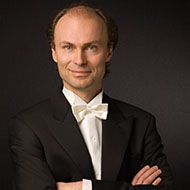At A Glance
DEBUSSY
Selections from Children’s Corner 1908 | 8 mins
La Plus que lente 1910 | 6 mins
Noël des enfants qui n'ont plus de maisons 1915 | 3 mins
For a long time, accepted wisdom maintained that nothing Debussy composed in his last decade or so was worth spending time on. His work, it was said, had degenerated into repetitive mannerism, and he was serving up little heaps of dry bones and ashes. Debussy had certainly changed. The gorgeous, enveloping lushness of the early works was gone. He was discovering the pleasures of economy, of textures that are more spare and linear, of rhetorical understatement, of humor, of the subtlest play of sound and idea. These qualities are on display both in the charming piano suite Children’s Corner, dedicated to Debussy’s young daughter Chouchou (officially Claude-Emma), and the Hungarian café homage La Plus que lente. Debussy’s last song, Noël des enfants qui n'ont plus de maison is a curious addition to his rich song catalogue. Here he adopts the breathless voice of a child in a plea against the atrocities of World War I.
FAURÉ
Allegro molto from Piano Quartet No. 1 in C minor 1879/1883 | 8 mins
During the 1870s, Fauré was a regular attendee at the salon of the famous mezzo-soprano and composer Pauline Viardot, and in the course of his visits there he fell in love with her daughter, Marianne. A failed engagement followed and the thirty-two-year-old composer was left temporarily heartsick. All the while Fauré was at work on his First Piano Quartet. While some have claimed to hear autobiographical echoes in the quartet, the composer’s friend and biographer Émile Vuillermoz protested against such an interpretation, writing “Fauré’s reserve always prevented him from following the example of Romantic artists who allowed the whole world to witness their personal frustrations.” Read More
RAVEL
The Enchanted Garden from Mother Goose 1910 | 4 mins
The direct inspirations for Mother Goose were children’s stories from seventeenth- and eighteenth-century French collections, especially Charles Perrault’s Contes de ma Mère l’Oye (Mother Goose Tales, published in 1697). Though an evocative score, Mother Goose was created with the elementary technique of child pianists in mind (it was written to be played by the children of some family friends). Even so, Mother Goose utters a distinct melodic language among Ravel’s works, while also revealing something completely authentic and characteristic. Read More
RAVEL
L’Enfant et les sortilèges 1925 | 45 mins
Dancing furniture, talking animals, fairy tale characters made real—L’Enfant et les sortilèges (The Youth and the Magic Spells) was a perfect project for a Ravel opera. He always adored children, and being diminutive himself he was delighted to find that children viewed him to some extent as “one of them.” There is no question that the pages of L’Enfant et les sortilèges convey an impression of child-like innocence, aspiration, and wonder, a sense hazily remembered by all of us but in most cases buried beneath the weight of years. PICTURE THIS: A young boy is having a bad day. He doesn’t want to do his schoolwork, and, with his mood vaulting from sullen indolence to uncontrolled rage, he goes on a frightening rampage whereby he trashes his elaborately furnished room. After sinking exhausted into an armchair, the magic and sorcery begin. Read More
THE PRODUCTION
A NOTE FROM CONCEPT ARTIST GRÉGOIRE POINT
My wish is to use animation as a living matter. This semi-staged version of L’enfant et les sortilèges is a marvelous opportunity for me to play with my graphic universe. One has the very strong feeling that Ravel uses this opera to demonstrate the amplitude of his musical palette. This is how I conceive the animations—with the development of a variety of stage pictures to create a multitude of visual effects.
A NOTE FROM DIRECTOR JAMES BONAS
L'enfant is an extraordinary work—a miniature so detailed, so finely wrought that it contains whole worlds within it. The combination of [librettist] Collette's imagination and Ravel's emotional and ambitious response to her text creates an amazing opportunity. Grégoire and I were clear about trying to find an approach to unleash that energy, and one that would set free both our minds and those of the audience. We found that when the singer, the animation, and the piece align in one seamless moment that's exactly what happens—something is released in the theater that is transporting and incredibly exciting.
Steven Ziegler is Managing Editor at the San Francisco Symphony


